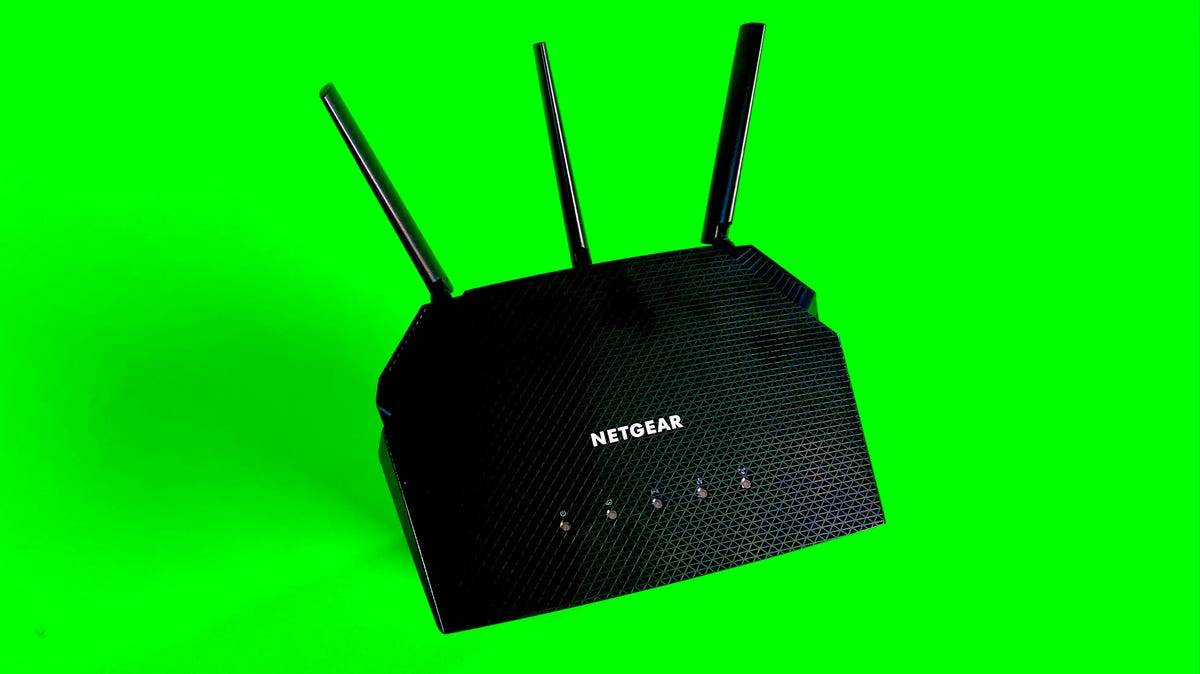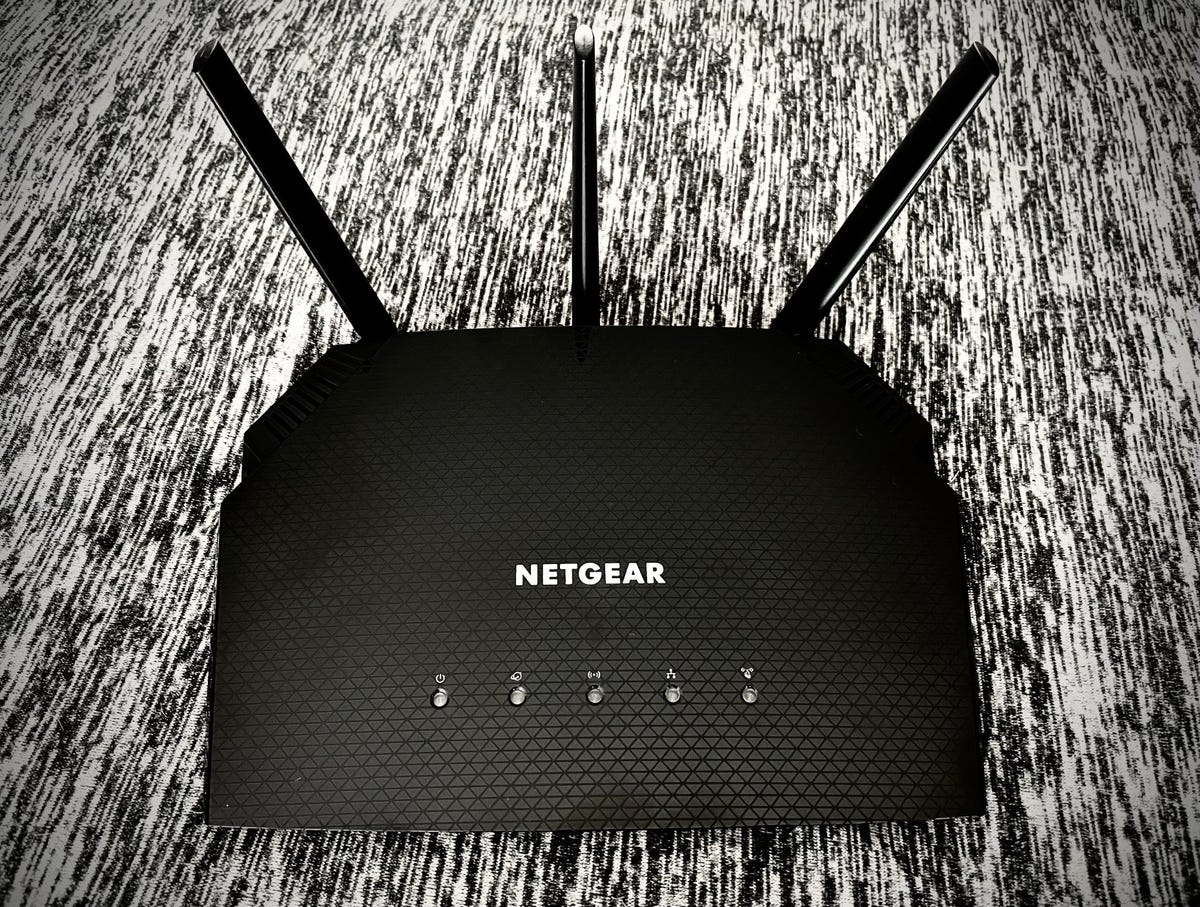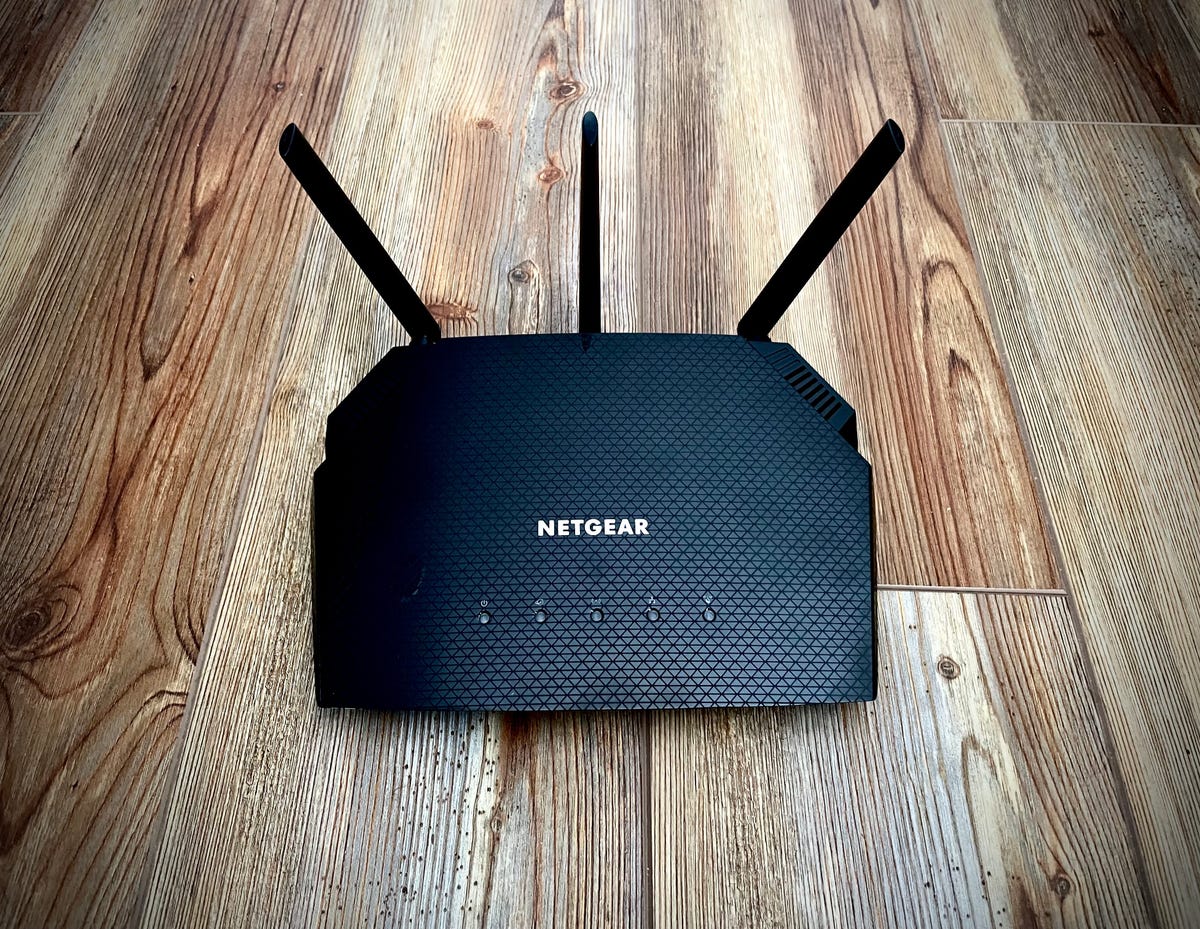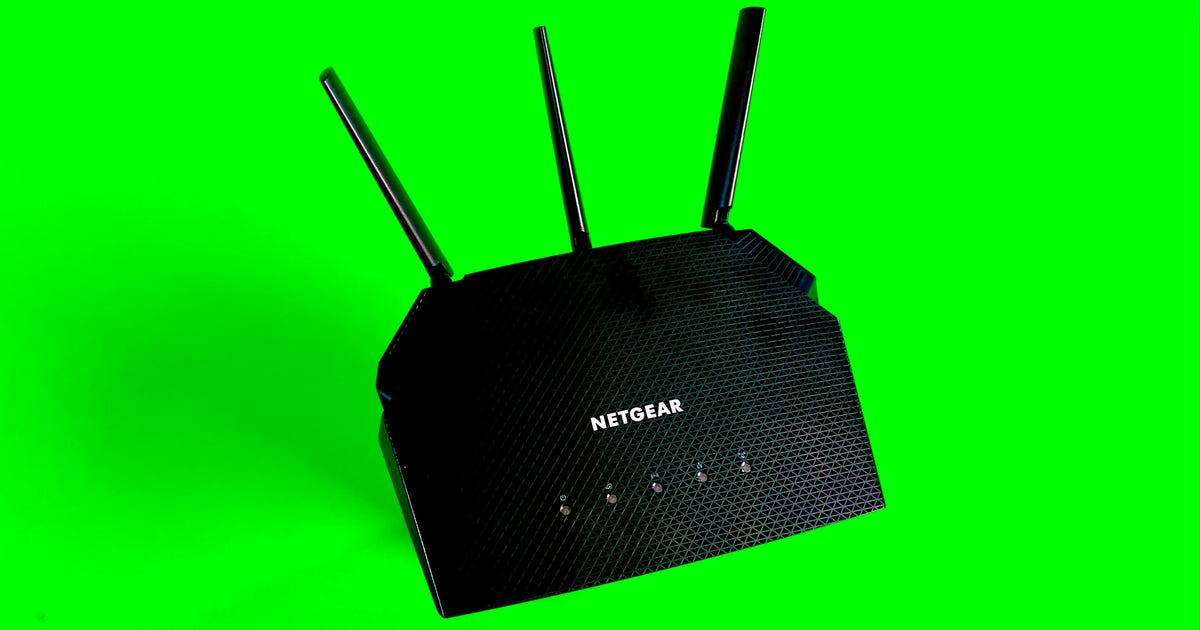Netgear R6700AX Review: Sturdy Speeds From This Affordable Wi-Fi 6 Router
Like
- Provides a stable, reliable connection to both current- and previous-gen Wi-Fi devices
- Stronger average upload speeds than comparable Wi-Fi 6 routers
- Easy, app-based setup takes less than 10 minutes
- Support for next-gen Wi-Fi 6 features and WPA3 security
Don’t Like
- Slightly higher latency than comparable AX1800 routers
- App has annoying ads for security and tech support services
- No USB jack
Just as 5G ushered in next-gen cellular connections, 802.11ax — aka Wi-Fi 6 — is the latest generation of Wi-Fi, with improved transmissions that are about 30% faster than before. If you’ve picked up a new laptop or phone recently, there’s a good chance it supports the standard, but you’ll need a Wi-Fi 6 router running your home network in order to take full advantage of those faster speeds at home.
You’re in luck. Though it initially hit the market as a premium upgrade a year or two ago, Wi-Fi 6 is fairly well entrenched at this point, and you’ll find plenty of Wi-Fi 6 routers up for sale that don’t cost an arm and a leg. That includes the Netgear R6700AX, which retails for $120 and often goes on sale for even less. As a matter of fact, as of writing this, it’s down to $90 on Amazon.

Ry Crist/CNET
A dual-band AX1800 router, the R6700AX supports top speeds of up to 1,200 megabits per second (1.2 gigabits per second) on its 5GHz band, with a slower 2.4GHz band that’s better for connecting at long range. I tested it against a few of the other top AX1800 options in that price range — the TP-Link Archer AX21 and the Asus RT-AX55 — and it held its own just fine, delivering fast speeds and low latency throughout the majority of my home. The Archer AX21 inched out ahead of the pack with faster average download speeds, but the R6700AX delivered faster average uploads, making the two more or less neck and neck in my eyes.
I’d put the Archer AX21 ahead of it for those slightly faster downloads, and for having the superior app — but the R6700AX is right behind it, and often available for less. You might want something a bit more powerful if you’re living with a gigabit internet connection at home, but the R6700AX is still well worth considering if you can catch it on sale, especially if you’ve got a shiny new Wi-Fi 6 phone or laptop at home and you want it to have the fastest, most advanced connection possible without breaking the bank.

Ry Crist/CNET
A clean design that looks the part
Your router will work best if you find a nice, open spot for it, and resist the urge to stash it away in a closet or behind your TV. That’s an easier pill to swallow if the thing isn’t ugly as sin, and fortunately, the R6700AX fits the bill. It’s a simple, clean design that looks the part of a modest budget model, but the subtle, angular touches give it enough of a sense of style that I don’t hate the sight of it. It isn’t fancy — and it’s a far cry from Netgear’s ostentatious Nighthawk routers, which look like they belong in the Batcave — but still, it’s appropriately modern and doesn’t look cheap.
The Netgear R6700AX features four spare Ethernet jacks in addition to the WAN port that you’ll use to connect it with your modem — but it lacks a USB port.
Netgear
As far as dimensions are concerned, the R6700AX is relatively compact — a little over 9 inches wide, a little over 7 inches deep, and a little over 2 inches tall, save for the three antennas. It runs on a quad-core, 1.5GHz processor and includes a built-in VPN, as well as support for WPA3, the latest standard for keeping your home’s Wi-Fi connections secure.
Turn the thing around, and you’ll find four spare gigabit Ethernet jacks in the back, in addition to the WAN port that you’ll use to connect it with your modem. Alas, it lacks a USB port, so you won’t be able to plug in an external storage device or any other peripherals of the kind — but plenty of us never use those USB jacks, anyway, so perhaps that’s a fair omission in a budget model like this.
Netgear’s Nighthawk app will walk you through setup in less than 10 minutes.
Screenshots by Ry Crist/CNET
About the app
The R6700AX isn’t one of Netgear’s Nighthawk-branded routers, but you can still use the Nighthawk app to set it up and manage your network settings. That’s an easier approach than setting it up the old fashioned way, by logging into the router’s IP address in your web browser, and Netgear’s app checks all of the boxes you’d want, making it easy to get your network up and running within about 10 minutes.

The Nighthawk app will regularly nag you to subscribe to Netgear’s premium security and technical support services, which gets a bit annoying.
Screenshot by Ry Crist/CNET
Once you’re online, you’ll be able to use the app to monitor the devices on your network, run a quick speed test or access things like the guest network, the parental controls and the VPN. Most prominent among these features is Netgear Armor, a suite of automated security features that costs $100 per year. You get 30 days to try it out, during which the app will regularly bombard you with pop-up flash screens encouraging you to sign up for the long haul. Same goes for Netgear’s premium tech support package.
That gets a little tiresome, and it’s the main reason I prefer other apps, like TP-Link’s Tether app, over the Nighthawk experience. Still, it’s a pretty minor quibble, especially since most people won’t use the app much at all after setup.
As for Armor itself, the marquee feature is regular, automatic threat scans for all of the devices on your network, which is nice to have if you’re worried about vulnerabilities among the growing number of cloud-connected gadgets under your roof. Armor also promises to detect anomalies on your network, protect against brute force hacking attempts, and prevent your home’s devices from getting swept up into a botnet and used in a DDoS attack. None of it is must-have, but it might be worth considering if network security is top of mind in your home.
The Netgear R6700AX (red) wasn’t quite as fast at range as the TP-Link Archer AX21 (blue), but it managed to outperform the Asus RT-AX55 (yellow).
Ry Crist/CNET
Let’s talk performance
During the pandemic, I tested routers in my 1,300-square-foot home in Louisville, Kentucky, where at the time of testing, I had incoming fiber internet speeds of 300Mbps. Like most routers I test, the R6700AX is capable of speeds that are a lot faster than that, but those tests still gave me a good look at how it stacks up against comparable routers in a real-world setting.
In this case, I tested the R6700AX against the TP-Link Archer AX21 and the Asus RT-AX55, two other budget-minded AX1800 routers with similar specs to what Netgear’s offering. The bulk of my tests consisted of tracking the router’s speeds throughout five different spots in my house, starting in the same room as the router and working back to the opposite end of the house, where a lot of routers struggle to maintain a strong signal.
The R6700AX did well here, with overall average download speeds of about 264Mbps throughout my entire home. That said, speeds fell all the way to 45Mbps in my back bathroom, the farthest spot from the router. The connection was still stable and usable, with no drops or stalls, so Netgear gets a passing grade here, but note that the TP-Link Archer AX21 performed better, with a back bathroom average right around 100Mbps and a near-perfect overall average of 299Mbps. Both are better suited for small-to-medium sized homes like mine than for larger living spaces, but if you’re picking between the two based on performance alone, I’d lean towards the AX21 for slightly better range.
This graph charts the latency results of each router I tested across all of my speed tests. The Netgear R6700AX (red) finished with average ping around 20ms and no spikes higher than 26ms, but both the TP-Link Archer AX21 (blue) and the Asus RT-AX55 (yellow) did better.
Ry Crist/CNET
Something else worth noting: Like Asus and TP-Link, the Netgear R6700AX offers a band-steering feature called Smart Connect that combines the 2.4 and 5GHz bands into a single network and automatically “steers” your device between them as needed. In each case, the feature is turned on by default, so that’s what I used to compile my averages, but in a small home like mine where range isn’t much of an issue, you may very well see better performance by turning it off and sticking to the 5GHz band.
That was the case here — the R6700AX’s 5GHz band finished with whole-home average download speeds of 298Mbps, which was about 35Mbps better than what I saw with band-steering turned on. That includes a triple-digit back bathroom average of 103Mbps, so the band-steering feature was likely kicking me over to 2.4GHz in that room unnecessarily. Still, it’s a lot better than the band-steering on other routers I’ve tested, including the Linksys MR7350, which often got tripped up and left me on 2.4GHz for entire rounds of tests as I moved through my house.
Downloads aside, it was Netgear that notched the fastest uploads of the three, with a whole-home average of about 196Mbps, slightly ahead of TP-Link’s 188Mbps and an average of 170Mbps from Asus. Even so, it was TP-Link that finished ever-so-slightly ahead in that back bathroom, with an average upload speed of about 17Mbps, which is more than twice as high as the Netgear or Asus average. The three are very close in terms of performance, and arguably within the margin of error of one another, but the slight performance boost at range is what gives TP-Link the edge.
I’d also nudge Netgear aside if you’re a gamer or anyone else especially concerned with latency, or the amount of time it takes the router to transmit data to a given server and receive a response. Though it did fine, with a very steady average ping of 20.42ms across all tests, and no spikes any higher than 26ms, both the Archer AX21 and the RT-AX55 did better, with average ping rates of 18.23 and 17.40ms, respectively. It’s a small difference, but a noticeable one if you’re regularly making competitive, split-second decisions while gaming online.
One final note: I also made sure to run two completely separate sets of tests with all three routers: one to a Wi-Fi 6 device, and one to an older Wi-Fi 5 device. In each case, speeds to the Wi-Fi 6 device were slightly faster, which is what you’d expect. Still, I saw the biggest boost with the Archer AX21, with whole-home average download speeds that jumped from 268Mbps with the Wi-Fi 5 device to 299Mbps with the Wi-Fi 6 device. With Netgear, the difference was much smaller, jumping from 258Mbps with the Wi-Fi 5 device to 264Mbps with the Wi-Fi 6 device.
On a gigabit network, the Netgear R6700AX delivered fast, consistent speeds, but it wasn’t able to hit speeds as fast as fancier routers like the Asus RT-AX86U.
Ry Crist/CNET
Gigabit speeds? Not quite
In 2022, we relocated our router-testing setup to our dedicated test lab, in Louisville. With a 1,350-square-foot multiroom test environment with max download speeds of 940Mbps and max upload speeds of 880Mbps, my methodology is essentially unchanged from my at-home tests, save for the faster speeds.
I’m still in the process of retesting our top-recommended routers on this new network (and testing plenty of new routers, too), but I made sure to add the R6700AX into the test queue to get an updated look at how it performs on a faster network than the one I originally tested it on.
The scatter plot above shows you how it did, with each dot representing my download speed during a single speed test in each of our setup’s five rooms. Across all of them, the R6700AX finished with an overall average download speed of 591Mbps, with short-range download speeds in the “living room,” where the router sits, ranging from about 600 to 800Mbps. Uploads, meanwhile, came in at 525Mbps when averaged across all tests in all rooms.
Overall, the results here were good — in fact, Netgear’s averages came in higher than the Archer AX21, which finished with average download speeds of 435Mbps and average upload speeds of 400Mbps. That might give the R6700AX the edge between the two of them on home networks that are faster than the national average, which currently sits at around 200Mbps, but I think most networks like that will want to spend up a bit for a model like the Asus RT-AX86U, which finished the same spate of tests with average downloads across the entire space of 822Mbps, and average uploads of 681Mbps.

The floor works well for photos, but please put your router up a little higher for better performance.
Ry Crist/CNET
The verdict
Wi-Fi 6 isn’t a mind-blowing upgrade in most homes — at best, you should expect speed increases to Wi-Fi 6 devices of about 25 to 30%, and that’s only if you have a gigabit connection. With a connection capped at a few hundred Mbps, you might only see average speed increases of 5 to 10%.
Even so, I think it’s an upgrade worth making at this point. More and more of the devices we keep filling our homes with are equipped to take advantage of Wi-Fi 6, and the standard’s ability to manage congestion better than before suits it well for our overwhelmingly digitized lives. Support for the latest security protocol, WPA3, is also something well worth buying into.
Most importantly, it’s an upgrade that doesn’t need to bust your budget — and that’s thanks to worthy entry-level models like the Netgear R6700AX. It’s a great buy if you can catch it for less than $100, but be sure to keep an eye on the TP-Link Archer AX21 and the Asus RT-AX55, as well. All three are terrific budget picks for those looking to take Wi-Fi 6 for a test drive in a small to medium-size home.
For all the latest world News Click Here



